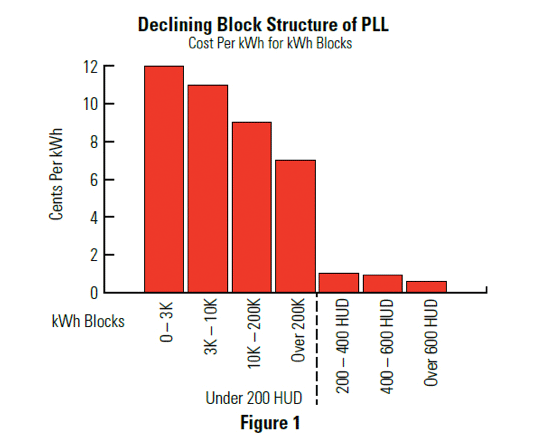The Power & Light tariffs (PL - Small, PL - Medium and PL - Large) are used by most commercial and industrial customers, as well as by some larger residential customers. The Power & Light tariffs have an hours use demand (HUD) structure, meaning not only energy consumption is used for billing, but also the rate at which the energy is used (demand).
Customers can get lower-cost energy by operating longer hours without increasing their rate of energy demand. One example of how to accomplish this is by going from a one-shift to a two or three-shift operation. Also, customers who have year-round consumption will generally enjoy a lower unit cost than a customer with seasonal or sporadic usage.
Customers who operate during times when the demand on Georgia Power's generating system is highest will pay a premium for that usage. Because large volume and constant users help Georgia Power operate its generating facilities more efficiently, they pay a lower unit cost for their electricity purchases.

Base Rate
Your base rate is determined by your overall billing demand and monthly energy usage, which is further applied to our rate structure as listed above.
Other Schedules – Common to All
Environmental Compliance Cost Recovery (ECCR)
Recovers capital costs and operating and maintenance costs associated with government-mandated environmental costs.
Nuclear Construction Cost Recovery (NCCR)
Recovers the cost of financing associated with the construction of a nuclear generating plant.
Demand Side Management Commercial (DSM-C)
Focuses on energy efficiency programs, such as financial incentives and consumer education, to help reduce commercial customers' power usage and control energy bills.
Fuel Cost Recovery (FCR)
A "pass-through" charge, with no profit, designed to recover all costs associated with fuel. It is separate from base rates because fuel costs vary. Georgia Power, with the Georgia Public Service Commission's approval, can raise or lower the FCR rate as necessary to recover fuel costs.
Municipal Franchise Fee (MFF)
Georgia Power has to pay a charge to cities for conducting business within their city limits and on the cities' rights-of-way. A Municipal Franchise Fee is designed to collect that money and is a "pass-through" charge, meaning Georgia Power earns no profit.
Glossary of Terms
Basic Service Charge
The basic service charge is a flat rate charged to every customer to recover administrative and other fees associated with providing power.
Billing Demand
Georgia Power is a summer-peaking utility because most of its customers have their highest usage during the summer months. The billing demand is a calculated number based on the peak demands set in the current month, plus the previous 11 months.
Kilowatt Hours (kWh)
Electricity usage is measured in kilowatt hours. A kilowatt hour is a measure of electrical energy equivalent to a power consumption of 1,000 watts for 1 hour.
Hours Use Demand (HUD)
Hours Use Demand (HUD) indicates how consistently a customer is using electricity during the billing month. The higher the HUD, the more hours the customer is operating and usually the lower their unit (kWh) cost. HUD determines how a customer is billed under the appropriate Power & Light tariff. The calculation for HUD is: HUD = Monthly kWh/billing demand kW.
Applicable Rate
The applicable rate is determined by the amount of energy your business uses (kW & kWh). There are three different categories:
Power & Light Small (PLS) – Under 30 kW — professional offices, small retails, small restaurants, franchises, small banks and hair salons.
Power & Light Medium (PLM) – 30-499 kW — grocery stores, department stores, office spaces or gas stations.
Power & Light Large (PLL) – 500 kW and over — big department and grocery stores, factories, high rises, malls and privately-owned hospitals.
Power and Light Rate Calculator
Our Power & Light Rate Calculator is an easy-to-use tool that showcases how your business currently uses energy and where you can save money going forward. Using your current Georgia Power energy bill, plug your information into our custom calculator to discover the many ways to save.
Which Rate is Right for You?
Our Commercial Rate Advisor tool can help you determine which rate plan best fits your lifestyle.
Go to Tool
